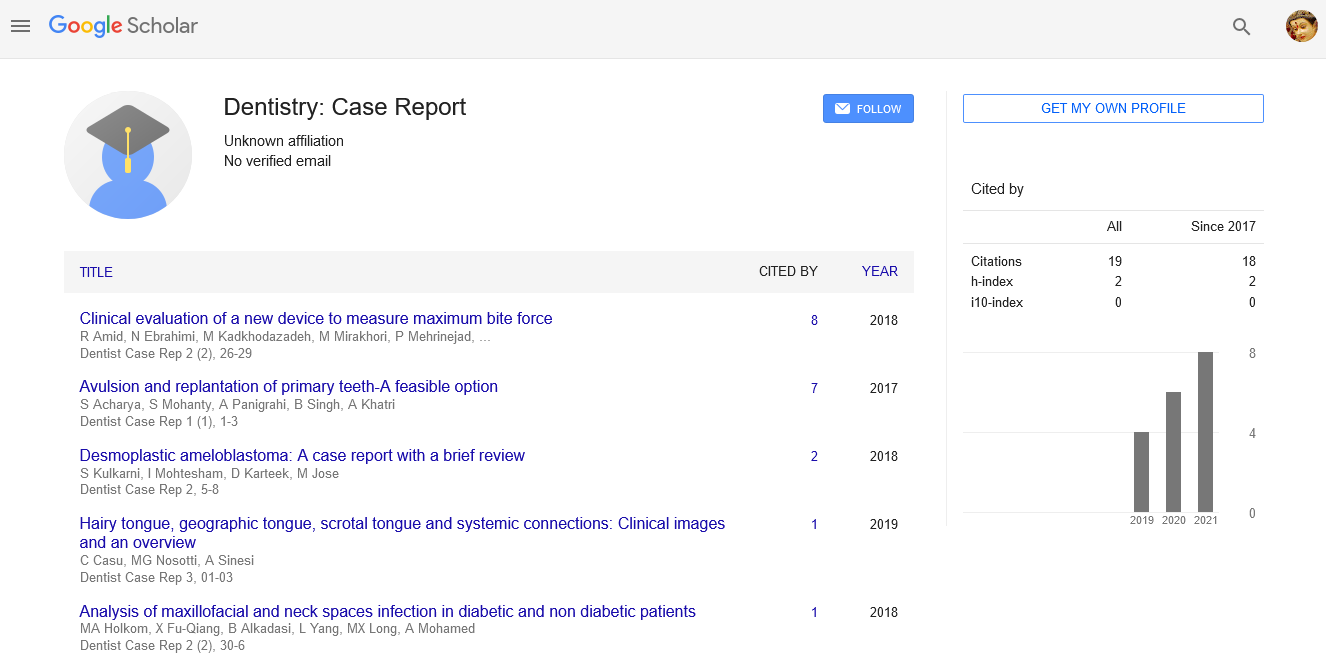Dental public health and dental diseases
Received: 11-Jan-2022, Manuscript No. puldcr-22-4665 ; Editor assigned: 13-Jan-2022, Pre QC No. puldcr-22-4665 ; Accepted Date: Jan 27, 2022; Reviewed: 20-Jan-2022 QC No. puldcr-22-4665 ; Revised: 24-Jan-2022, Manuscript No. puldcr-22-4665 ; Published: 27-Jan-2022, DOI: 10.37532. puldcr.22.6.1.1
This open-access article is distributed under the terms of the Creative Commons Attribution Non-Commercial License (CC BY-NC) (http://creativecommons.org/licenses/by-nc/4.0/), which permits reuse, distribution and reproduction of the article, provided that the original work is properly cited and the reuse is restricted to noncommercial purposes. For commercial reuse, contact reprints@pulsus.com
Abstract
Dental public health is a non-clinical approach to community health. The fluoridation of water is the most well-known oral public health impact. Rather of treating diseases on an individual basis, public health focuses on preventing sickness in big populations. The dental applications of bioengineering materials have considerably broadened within the last few decades.
Introduction
Dental public health focuses on the health of populations in a non-clinical way. The most widely known dental public health implication has been the fluoridation of water. A major focus of public health is preventing disease in large populations, rather than treating diseases on an individual basis.
Evidence-Based Dentistry is an approach to oral health care that requires the judicious integration of systematic assessments of clinically relevant scientific evidence, relating the patient's oral and medical condition and history, with the dentist's clinical expertise and the patient's treatment needs and preferences. Evidence-Based care is a global movement in all the health science disciplines. It represents a philosophical shift in the approach to practice a shift that emphasizes evidence over opinion and at the same time, judgement over blind adherence to rules.
DENTAL BIOMATERIALS AND BIOENGINEERING
Bioengineering materials usually develop tissue-biomaterial interactions that suitably recapitulate a tissue or organ and integrate well with surrounding tissues which can achieve the desired results in human patients and greatly improve their care. The dental applications of bioengineering materials have considerably broadened within the last few decades. The field of bioengineering materials needs to move toward new dental treatment concepts based on the fact of value-consciousness in the healthcare and biotechnology areas and utilizations that can create the future of this field.
Only a few commercially available dental biomaterials have passed all biocompatibility screening standards, ensuring that they are low in toxicity, safe, clinically effective, and useful to patients. Because they were approved through a grandfathering approach, most dental biomaterials have never been assessed for biocompatibility. The grandfather procedure permits biomaterials to be sold and promoted without going through biocompatibility testing as long as they have the same chemical composition, sterilisation, manufacturing process, and quantity of body contact as marketed biomaterials.
Metals, polymers, ceramics, and composites are all examples of dental biomaterials. These materials are used to either prevent or correct problems and unlike most other biomaterials, some dental biomaterials are visible, therefore matching the colour of the surrounding tissue can be vital.
Dental implants frequently use metals as anchors. They give the necessary strength to keep the implant in place in the bone despite the forces that the mouth experiences. Titanium and its alloys, cobaltbased alloys, and stainless steel are among the metals. Metal can also be used for dental crowns and bridges. Crowns made of gold are very prevalent. Dental amalgam is a filler material made up of mercury, copper, tin, zinc, and silver that is used to fill cavities following tooth decay.
PREVENTIVE, COMMUNITY DENTISTRY AND ORAL EPIDEMIOLOGY
The process of caring for your teeth in order to keep them healthy is known as preventive dentistry. Community dentistry is a discipline of dentistry that focuses on avoiding disease, extending life, and enhancing physical and mental efficiency through coordinated community activities such as environmental sanitation, communicable disease management, and personal hygiene education. Oral epidemiology identifies people at risk of oral disease or in need of specific treatment, compares regional, environmental, social, and access similarities and variations in dental care amongst populations, and provides information on normal biological processes and disorders of the oral cavity. It also examines the effectiveness and quality of therapies and oral health programmes, as well as testing preventative measures for disease control.





